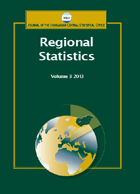How the Trianon Peace Treaty impeded social and
spatial structure progress in the Bánság (1918–2010)
How the Trianon Peace Treaty impeded social and
spatial structure progress in the Bánság (1918–2010)
Author(s): Sándor KókaiSubject(s): History, Social Sciences, Economy, Geography, Regional studies
Published by: Központi Statisztikai Hivatal
Keywords: Trianon Treaty; Bánság; spatial structure
Summary/Abstract: This study discusses different geographic relationships and highlights a few regional problems in the Bánság and the surrounding area. The Bánság, being a separate region, has its own development curve, structure, and related systems. The region has internal cohesion and a particular texture, reflected among people living there today and those who are familiar with this area. The Bánság, based on local and situational energies, is a separate region born from socioeconomic self development,where the socioeconomic processes and changes in the state organisation reflect the combination of regionalisation and regionalism, and their interdependence. At the end of the 19th century it became the most developed region in the Carpathian Basin. The Trianon Peace Treaty caused many problems (e.g. economic, national, etc.), affecting its traditional spatial structure and social connection.
Journal: Regional Statistics
- Issue Year: 10/2020
- Issue No: 01
- Page Range: 133-150
- Page Count: 18
- Language: English

